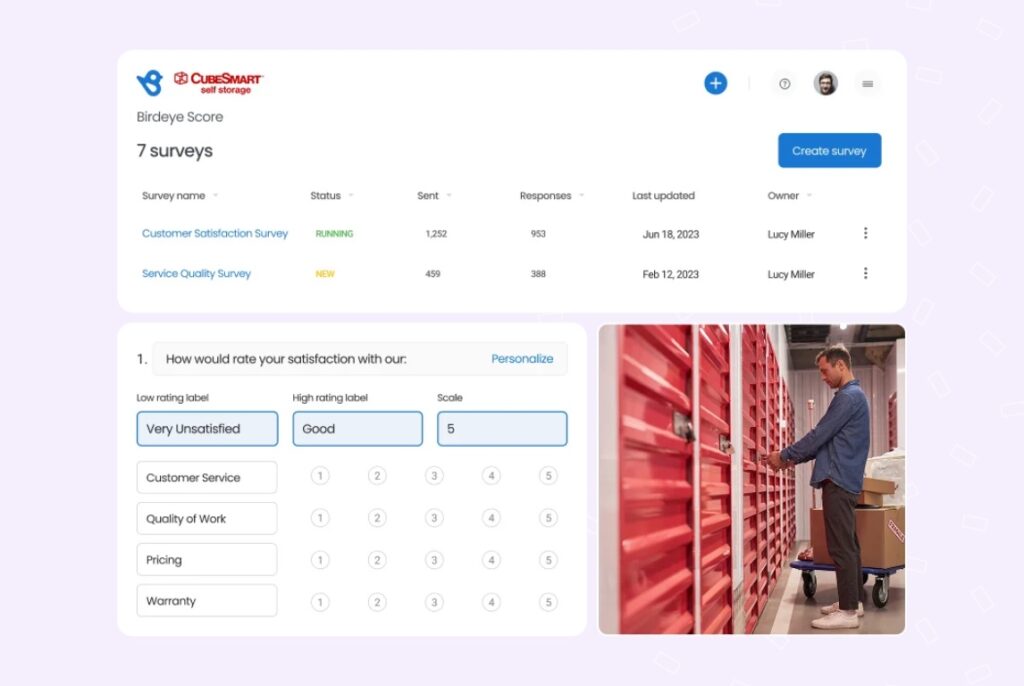Why do two people with the same income, interests, and location respond to the same product in completely different ways? The answer lies not just in customer behavior but in why that behavior occurs. That's what makes customer behavior analysis such a powerful strategy for modern brands.
Most businesses already track clicks, reviews, and survey scores, but that’s only half the story. True growth comes from understanding customer behavior: decoding the behavior patterns, decision triggers, and emotions that shape every purchase.
Whether you’re launching new marketing campaigns or refining the customer journey, it all starts with learning how your customers interact and why they act the way they do.
And in 2025, understanding this ‘why’ is more important than ever.
According to Birdeye’s 2025 State of Online Reviews, review volume grew by 13% in just one year, and 81% of all reviews were left on Google. This surge shows just how much customer feedback influences decisions, not just as a record of what happened, but as a window into why people make the choices they do.

In this blog, we’ll walk you through a strategic, psychology-backed guide to customer behavior and show you how to build rapport with customers.
You’ll also learn how to collect customer data, uncover valuable insights, and use that knowledge to shape more effective marketing strategies that speak to your target audience.
Table of contents
- What is customer behavior analysis?
- Understand the psychology behind customer decisions
- Key elements of effective customer behavior analysis
- Why customer behavior analysis matters in 2025
- How to conduct a customer behavior analysis
- Tools that help decode customer behavior
- How National Storage Affiliates approached customer behavior analysis across 1,100+ locations
- FAQs about customer behavior analysis
- Master customer behavior analysis with Birdeye
What is customer behavior analysis?
Customer behavior analysis is the process of examining how, when, where, and why customers make purchasing decisions across every interaction and touchpoint. It helps you move from assumptions to evidence, using real-world data to uncover the motivations behind customer actions.
Unlike traditional market research, which often relies on opinions or surveys alone, this method goes further. It looks at actual behavior—clicks, purchases, reviews, and interactions—and pairs it with emotional or psychological context. Let’s break it down simply:
- Quantitative data shows you what happened (e.g., how many people abandoned checkout).
- Qualitative data reveals why it happened (e.g., product doubts, shipping concerns).
Together, these insights help you identify online review trends, segment users more meaningfully, and tailor marketing strategies that feel relevant and timely.
Here’s a quick comparison to clarify where customer behavior analysis fits:
| Approach | Focus | Limitation |
| Market research | Opinions and feedback | May not reflect real behavior |
| Customer journey mapping | Experience flows and stages | Doesn’t explain the underlying motivation |
| Customer behavior analysis | Actual decisions and motivations | Offers both data and context |
Pro tip: A complete analysis often includes customer payment behavior analysis to understand timing, frequency, and purchase value trends — especially useful for financial services, subscriptions, and retail.
Today, businesses are also adopting AI customer behavior analysis to identify patterns that humans might miss, such as emotional sentiment behind reviews or repeat behavior before churn. These tools make it easier to scale insights across thousands of interactions and take action quickly.
Understand the psychology behind customer decisions
Once you understand what customers are doing, the next step is to understand why. This is where psychology steps in. Purchasing decisions are rarely rational. Whether it’s choosing a dentist, booking a hotel, or signing up for a subscription, the final decision is often influenced by emotion, not just logic.
Here are some of the psychological triggers that influence customer buying behavior analysis:
- Cognitive biases: Customers are influenced by patterns like social proof (“If others like it, I will too”), anchoring (“This price seems low compared to what I saw before”), and loss aversion (“I don’t want to miss this deal”).
- Emotional drivers: Fear, trust, urgency, and even ego shape whether customers buy now, delay, or leave altogether.
- Perceived risk and value: People buy if the value outweighs the risk. If not, they hesitate—even if the product is perfect on paper.
- Expectations: What customers expect before they interact with you determines how satisfied they are afterward. A well-designed customer journey manages those expectations at every touchpoint.
For example, B2C customers may respond more to impulse triggers, like urgency or discounts. B2B customers, on the other hand, may be driven by longer decision cycles, multiple stakeholders, and trust in the brand’s authority.
That’s why customer behavior analysis should never rely on metrics alone. To truly understand what motivates action, businesses must pair behavioral data with psychological insight.
This is where AI customer behavior analysis becomes game-changing. AI can process online reviews, social comments, and open-ended feedback to detect emotional sentiment and psychological patterns that are invisible in raw data.
According to Birdeye’s 2025 report, customers have moved beyond just giving 5 or 3-star reviews. Most of the reviews now include comments, giving businesses more emotional and contextual insights than ever before.
By integrating behavioral cues with psychological motivators, you can design personalized marketing campaigns that speak directly to what your audience cares about — and convert more effectively.
Key elements of effective customer behavior analysis
To understand what drives customers to act, businesses need more than just raw data. They need a structured approach to analyzing customer behavior that blends observation, emotion, and context. Let’s break down the foundational elements of a high-impact analysis:
A. Qualitative and quantitative data collection
Effective customer behavior analysis starts by gathering both measurable actions and emotional context. Here are the four pillars that support deeper understanding:
- Behavioral data: Tracks what, including clicks, drop-offs, time on site, and conversion paths. These patterns show how customers navigate your digital touchpoints.
- Psychographic profiles: Capture values, beliefs, attitudes, and customer preferences to reveal the emotional and motivational side of decision-making.
- Customer journey stages: Analyze how customers move through awareness, consideration, decision, and loyalty. Each stage offers unique opportunities to engage.
- Voice-of-customer signals: Reviews, customer feedback, survey comments, and chat transcripts offer rich context into satisfaction, confusion, or unmet expectations.
Together, this qualitative and quantitative data provides a more complete picture of how customers interact with your business across the entire customer journey.
Example: If a customer clicks on multiple product pages but doesn’t convert, quantitative data shows the drop-off. But a review comment about unclear pricing gives the qualitative insights you need to fix it.
B. Behavior-based audience segmentation
Behavioral customer segmentation allows you to go beyond static traits like age or geography. Instead, you can group customers by how they behave, what they value, and where they drop off.
Some segmenting dimensions include:
- Customer characteristics: Purchase frequency, recency, average spend
- Customer behavior patterns: Whether they’re loyal, price-sensitive, or experience-driven
- Customer preferences: Preferred channels, content formats, or messaging tone
- Customer segment: Grouping based on interaction intent or journey stage
Customer Behavior Analysis: Think Like Your Customers
Want to see the impact of Birdeye on your business? Watch the Free Demo Now.
This behavior-led segmentation enables targeted marketing campaigns, smarter automation, and personalization that feels timely, not generic.
C. Use tools that uncover patterns and prevent churn
Modern customer behavior analysis tools help teams process large volumes of customer behavior data and identify trends faster. These include:
- Heatmaps and session recorders (e.g., Hotjar, Microsoft Clarity)
- Behavior-integrated CRMs
- AI customer behavior analysis platforms like Birdeye
One standout example of customer behavior analysis is Birdeye Insights AI, which National Storage Affiliates uses. By analyzing customer review sentiment across 1,100+ storage facilities, they detected negative patterns and minimized churn with automation.
Such deeper insights helped them intervene early, course-correct local operations, and reduce cancellations. This proved that deep behavioral insights can drive customer retention when acted on proactively.
When you combine data, psychology, and segmentation with the right tools, you don’t just track user behavior. You gain clarity on how to personalize outreach, improve products, and grow trust.
Why customer behavior analysis matters in 2025
The way customers engage with businesses has changed—permanently. With more platforms, more choices, and less attention than ever before, businesses can no longer rely on assumptions or outdated models.
That’s where customer behavior analysis becomes critical. It’s not just a nice-to-have; it’s a competitive edge.
Here’s why it’s more relevant than ever:
1. Customer expectations are higher, and patience is lower
Today’s customers expect speed, relevance, and a seamless customer experience—and they won’t hesitate to leave for a competitor if something feels off. Understanding their preferences and behavior in context allows you to act before problems arise.
📈 According to Birdeye’s 2025 report, review response rates rose from 63% to 73%, showing how brands are prioritizing speed and emotional intelligence to build trust.
2. It helps increase retention and customer lifetime value
Retaining an existing customer is more cost-effective than acquiring a new one. By identifying customer pain points, habitual buying behavior, or signs of churn early, you can tailor customer experience transformation efforts that grow customer lifetime value.
3. It unlocks stronger customer segmentation
Behavioral insights allow you to go beyond broad personas and create customer segments that reflect real motivations. This leads to more accurate targeting, better messaging, and targeted marketing campaigns that convert.
4. It powers more effective marketing strategies
When you align your marketing efforts with real user behavior, the result is better ROI and relevance. Whether it’s email, SMS, or website personalization, behavior-led decisions drive performance across touchpoints.
5. It drives business success
Ultimately, brands that truly understand their customer base can adapt faster, serve better, and grow smarter. This leads to stronger brand loyalty, increased customer satisfaction, and long-term customer loyalty.
💡Companies that build systems to generate deep customer behavior insights are more likely to retain high-value customers and deliver actionable insights that move the needle across departments.
How to conduct a customer behavior analysis
Now that you know what to collect and which tools to use, the next step is putting your customer behavior analysis into action. A clear, repeatable process helps teams turn scattered data into valuable insights that drive smarter decisions and stronger results.
1. Define your business goal and outcome metrics
Start by identifying what you want to learn or improve. Are you looking to reduce churn, increase customer acquisition, optimize your marketing messages, or improve customer satisfaction?
Your goal will shape:
- The types of customer behavior you track
- What tools and data sources do you need
- How do you define success
2. Gather the right customer behavior data
Don’t just focus on traffic volume or page views. Instead, collect:
- Customer interactions across channels (website, app, support)
- Customer feedback from surveys, reviews, and chat transcripts
- Social media engagement metrics that reflect brand sentiment
- Insights from focus groups or product usability sessions
- Emotional and rational triggers captured in customer journey maps
Make sure this data includes both qualitative and quantitative insights to get a complete picture.
3. Analyze your findings to identify patterns
Once data is collected, dive into data analysis to uncover trends:
- What are high-performing segments doing differently?
- Where are drop-offs or delays happening?
- Which moments in the customer journey have friction or hesitation?
- What external factors (economic, seasonal, competitive) influence decisions?
Tools like customer behavior analytics platforms and predictive analytics can surface early churn signals, recurring pain points, or untapped segments that lead to growth.
4. Segment and activate your customer insights
Now use behavioral segmentation to group existing customers and prospects based on shared actions, values, or needs. Create behavior-based customer segments that can power:
- Targeted campaigns with messaging that aligns with preferences
- Personalized offers for loyal customers or habitual buying behavior
- Win-back flows for disengaged groups
- Service improvements for long-term customer retention
Segmented data allows brands to engage differently with high-value versus first-time buyers, improving both short- and long-term ROI.
5. Make customer behavior analysis an ongoing process
One-time studies won’t deliver long-term results. Behavioral patterns shift with new trends, products, and platforms. Treat your analysis as an ongoing process that feeds your customer experience, marketing efforts, and product innovation.
When done consistently, understanding consumer behavior gives brands a competitive advantage. It helps them adapt, engage faster, and build deeper loyalty than brands that rely solely on intuition.
Tools that help decode customer behavior
Once you’ve structured your data and identified your goals, the next step is choosing the right tools to decode patterns and act on them. No shortage of platforms claim to help with customer behavior analysis, but not all of them provide the depth or scalability modern brands need.
Let’s look at the main categories of tools and what they offer.
1. Traditional tools for basic behavior tracking
These tools help capture user actions and measure performance across digital touchpoints:
- Google Analytics: Provides macro-level customer behavior data like bounce rates, traffic sources, and conversion funnels.
- Hotjar or Microsoft Clarity: Offer heat maps, scroll depth, and session replays to track user behavior on-site.
- CRM platforms: Store and manage customer data, customer engagement history, and preferences in one place.
- Manual surveys and polls: Capture direct customer feedback on pain points, product satisfaction, or post-purchase experiences.
While useful, these tools often lack emotional insight, automation, or centralized analysis across channels.
2. Birdeye: A centralized, AI-driven customer behavior analysis platform
Where traditional tools end, Birdeye begins. With purpose-built AI solutions that work together, Birdeye helps businesses move from fragmented data to full-funnel understanding.
Here’s how each GenAI product supports analyzing customer behavior more deeply:
Birdeye Insights AI
- Pulls omnichannel signals from reviews, surveys, and customer satisfaction metrics to generate customer behavior insights in one dashboard.
- Offers customer sentiment score, reputation, and location-level analysis using AI recommendations.
- Delivers clear summaries and score changes with Smart Insights, highlighting what to fix and why.
- Trusted by brands like National Storage Affiliates, who used it to spot churn risks early across 1,100+ storage sites, preventing customer loss before it occurred.

Birdeye Survey AI
- Enables you to launch automated, multi-channel surveys to capture qualitative data at scale.
- Uses AI-driven analysis to summarize feedback, identify patterns, and highlight hidden pain points.
- Creates tailored surveys with logic-based flows and auto-routing for faster issue resolution.
- Helps businesses respond to feedback in real time and improve customer satisfaction.

Birdeye Competitors AI
- Benchmarks your customer experience, sentiment, and visibility against competitors by location and industry.
- Breaks down reviews, ratings, and social presence into digestible themes to reveal external factors impacting behavior.
- Identifies gaps in your performance and surfaces actionable insights to strengthen your position.

This ecosystem of tools makes Birdeye one of the only platforms that can deliver a connected view of the customer journey, combining behavior with emotion, competition, and intent.
How National Storage Affiliates approached customer behavior analysis across 1,100+ locations
National Storage Affiliates, one of the largest self-storage brands in the United States, offers a textbook example of using AI-powered insights to improve customer experience across hundreds of locations.
The challenge
With over 1,100+ facilities, National Storage Affiliates faced a common multi-location challenge: tracking customer sentiment at scale. Reviews were being collected, but without context or consolidation. Negative feedback often went unnoticed until it impacted operations, leading to avoidable churn and inconsistent service quality across sites.
They needed a way to:
- Centralize customer feedback from multiple locations
- Detect early signs of dissatisfaction
- Take action before customer experience issues turn into revenue loss
The solution: Birdeye Insights AI
National Storage Affiliates adopted Birdeye Insights AI to make sense of large volumes of unstructured review data. Here’s what changed:
- The platform automatically pulled in customer feedback from reviews across all facilities and organized it into categories such as pricing, cleanliness, and staff interactions.
- They used AI summaries to track sentiment trends by location and highlight which properties were at risk.
- Teams received AI-generated recommendations to address key issues like slow responses or unclear access instructions.
- By acting on those insights, local teams could resolve problems before customers left.
The result: Reduced churn and smarter decisions
They turned thousands of review comments into actionable insights—using behavior patterns to strengthen loyalty, standardize operations, and retain more customers.
Instead of relying on anecdotal complaints, the brand could now clearly identify systemic issues and move quickly to improve them.
FAQs about customer behavior analysis
Customer behavior analysis is important because it helps brands understand not just what customers do, but why they do it. These insights improve targeting, reduce churn, and increase satisfaction across every stage of the complex buying behavior cycle.
Basic analytics track metrics. Customer behavior analysis connects those metrics to intent, emotion, and patterns — helping businesses act faster and personalize more effectively.
A: Absolutely. Metrics like comments, shares, and sentiment from platforms like Facebook and Instagram provide social media engagement metrics that help uncover trends, preferences, and emerging feedback signals.
Multi-location businesses, healthcare, finance, real estate, and retail — especially those with long or complex buying behavior — benefit from predictive insights and segmented targeting powered by behavior analysis.
Master customer behavior analysis with Birdeye
Understanding what customers do is helpful, but knowing why they do it is transformative. That’s why customer behavior analysis is essential for brands looking to reduce churn, improve experiences, and drive growth.
With Birdeye GenAI tools like Insights AI, Survey AI, and Competitors AI, businesses gain the real-time visibility they need to decode sentiment, uncover blind spots, and act before issues escalate.
👉 Ready to unlock deeper behavior insights across every touchpoint?
Birdeye is built for that.

Originally published









